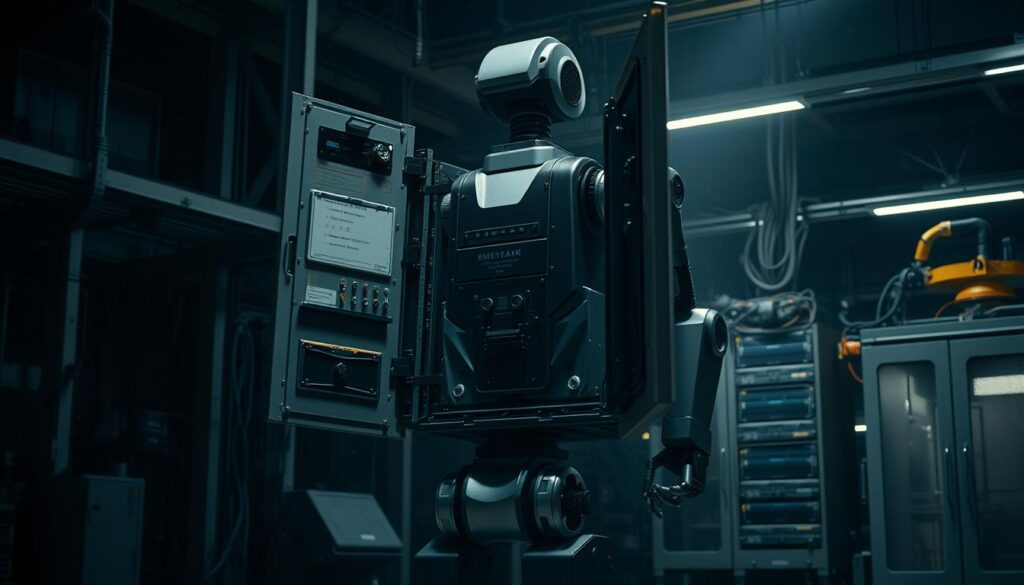Smart factory technology is changing manufacturing with advanced robots. These systems make factories more efficient and productive. But, they also bring big cybersecurity risks that need to be fixed fast.
Networked robots create complex digital worlds. Every connected device is a possible weak spot. Hackers can use these systems to attack factories, threatening their operations.
Now, making robots safer is key. A cyberattack could stop a whole factory line. This could cost a lot of money and hurt operations. So, strong security is a must for smart factories.
Manufacturing’s digital shift offers big chances. Investing in good security can help avoid risks. This way, smart robots can keep improving factories safely.
Understanding Smart Factory Vulnerabilities and Security Challenges
The world of industrial automation has changed a lot. Now, smart factories use complex networks of robots to make things more efficient. But this new tech also brings big cybersecurity risks.
Modern robots and systems are connected in ways that make them vulnerable to cyber threats. These networks can be attacked, which could stop whole production lines.
Impact of Cyberattacks on Manufacturing Operations
Cyberattacks on factory automation can lead to serious problems:
- Production lines can shut down
- Equipment can get damaged
- Data can be stolen
- There can be big financial losses
Evolution of Industrial Robot Security Threats
Bad guys keep finding new ways to attack industrial systems. The complex networks of robots offer many ways for hackers to get in.
Critical Infrastructure Protection Requirements
To keep smart factories safe, we need strong security plans:
- We should check for vulnerabilities often
- Use advanced systems to find threats
- Make sure access is controlled well
- Keep training employees on cybersecurity
Managing these cybersecurity challenges is key to the future of industrial automation.
Common Attack Vectors in Networked Industrial Robots
The world of industrial robotics is facing new cybersecurity challenges. Robots and automated systems are being targeted by hackers. It’s important to know how to protect these systems.

Cybercriminals use many ways to attack networked industrial robots. They find weak spots in these complex systems.
Malware and Ransomware Threats
Malicious software is a big threat to industrial control systems. Hackers create advanced malware to:
- Get into robotic programming networks
- Take control of systems
- Lock up important manufacturing data
- Ask for money from companies
Man-in-the-Middle Attack Scenarios
Robotic systems’ communication channels are at risk of being hacked. Attackers can:
- Watch data being sent
- Change how data is sent
- Send fake commands
- Damage automated systems
DDoS and Network-Based Attacks
Distributed denial-of-service attacks flood industrial robot systems. These attacks can:
- Stop important systems from working
- Break production flow
- Cost companies a lot of money
It’s key to take steps to prevent these growing cybersecurity threats in industrial robotics.
Industrial Robotics Development: Security Implications
Robotic technology is changing how we make things. As robots get smarter, keeping them safe becomes a big deal. Companies using advanced robots face new security challenges.
Important security issues in robotic development include:
- Creating strong IT and OT security plans
- Checking robotic systems for weaknesses
- Building robots with security in mind
- Staying ahead of new cyber threats
Companies need to act fast to protect their robots. They should check their security plans and find new ways to keep robots safe from hackers.
Keeping robots safe needs a team effort. Robot makers should focus on:
- Understanding all risks
- Finding new ways to spot threats
- Keeping security up to date
- Working together between tech and engineering teams
Modern robots are complex and need strong security. As more systems connect, keeping factories safe is more important than ever.
Authentication and Access Control Weaknesses

Modern robotics software development faces big challenges in securing industrial control systems. The growing complexity of robotic system integration has shown big weaknesses in how we authenticate and control access. These weaknesses can put entire manufacturing environments at risk.
Networked industrial robots bring many security risks that companies must tackle. These risks come from not having strong enough protection strategies. This leaves critical systems open to cyber threats.
Controller Security Vulnerabilities
Industrial robot controllers often don’t have strong security. Key weaknesses include:
- Weak or default authentication credentials
- Unencrypted communication protocols
- Limited access control mechanisms
- Outdated firmware with known security gaps
Remote Access Risks
Remote connectivity in robotics software development brings big security challenges. Manufacturers often make remote access easy without strong security. This creates chances for hackers to get in.
- Unsecured FTP and web interfaces
- Unprotected API endpoints
- Insufficient user authentication mechanisms
Wireless Security Concerns
Wireless connections in robotic system integration are another big risk. Possible dangers include:
- Eavesdropping on communication channels
- Unauthorized device infiltration
- Signal interception and manipulation
Companies must focus on strong security plans to tackle these complex risks in industrial robotics.
Supply Chain and Third-Party Security Risks
Automated manufacturing solutions face big security challenges. These come from complex supply chain networks. The many parts of industrial robotics create several weak spots. These can put factory automation safety at risk.
Third-party integrators and software providers are big security risks. They make key programs and control systems for robots without checking for security. The dangers include:
- Unverified software development processes
- Potential insertion of malicious code
- Inadequate security vetting of hardware components
- Backdoor access opportunities in robot control systems
System integrators write robot programs. Manufacturers often use these programs without checking for security. This makes it easy for third-party systems to bring in security threats.
Companies need to check the security of all outside partners well. They should do regular security checks, screen vendors carefully, and watch third-party software closely. This helps keep industrial robotics safe.
Managing risks well means using a layered approach to supply chain security. By setting strict checks and being open with tech providers, makers can lower security risks in their systems.
Conclusion
Industrial robotics development is key in smart factory technology, and security is vital. The complex world of networked industrial robots needs a strong security plan. This plan should cover all stages, from design to ongoing use.
Protecting automated systems needs a complete approach. Security-by-design is now a must, not just a choice. Every connected device in smart factories is a risk for cyber attacks. So, we need strong authentication, constant monitoring, and flexible defense.
Working together is essential for the future of industrial robotics. Cybersecurity experts, robotics engineers, and leaders must team up. They should invest in training, use advanced threat detection, and stay alert to new digital dangers.
Regular security checks and updates are key to keeping robotic systems safe. As industrial automation grows, so does the need for ongoing security efforts. By focusing on strong security, manufacturers can use the power of networked robots safely and effectively.

